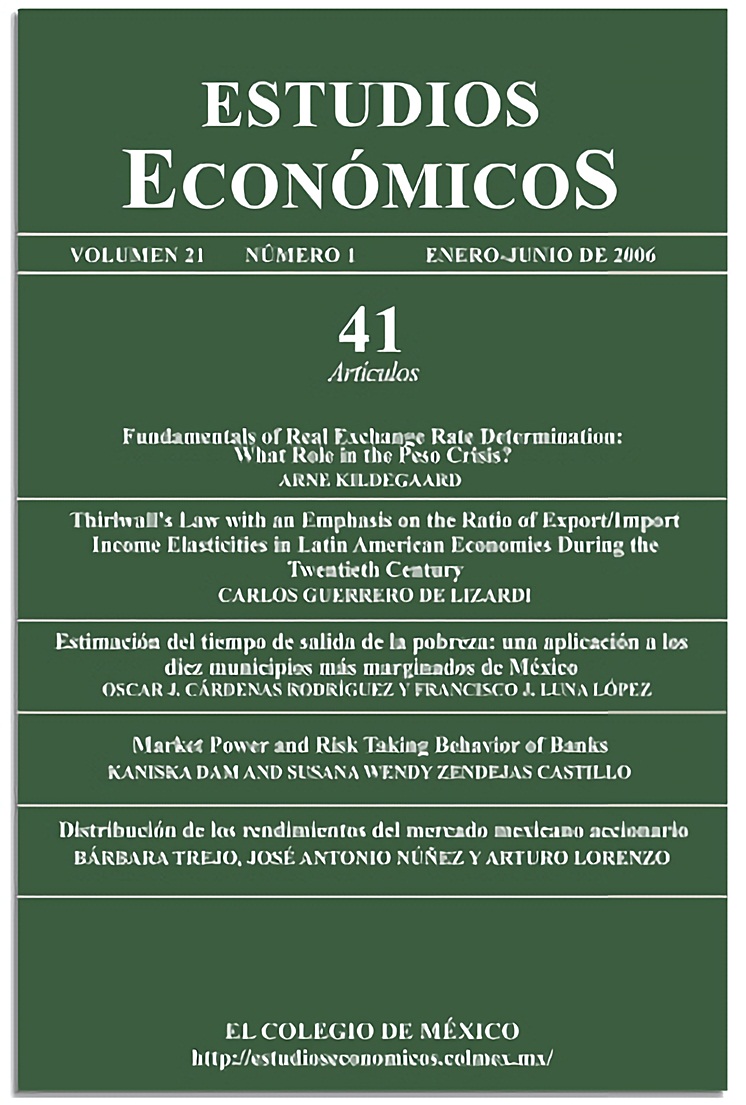Factores fundamentales de la determinación del tipo de cambio real: ¿Qué papel desempeña en la crisis del peso?
Publicado 2006-01-01
Palabras clave
- tipo de cambio real,
- paridad de poder adquisitivo,
- crisis cambiaria,
- cointegración
Cómo citar
Resumen
Se investiga el papel desempeñado por factores estructurales en el comportamiento históricos del tipo de cambio real en México. Se demuestra que determinantes “fundamentales” (que se omitieron en investigaciones anteriores) son cointegrados con el tipo de cambio nominal y los precios relativos, mientras una prueba de la versión sencilla de PPA (sin los factores fundamentales) falla. La ecuación de cointegración indica una subvaluación severa a finales de los 1980s y una sobrevaluación ligera antes de la devaluación de principios de diciembre de 1994. Los factores fundamentales no son capaces de explicar la magnitud del choque que recibió México en aquel momento.
Descargas
Citas
- Aspe, Pedro (1993). Economic Transformation the Mexican Way, Cambridge, MIT Press.
- Ávalos A. and F. Hernández (1995). Comportamiento del tipo de cambio real y desempeño económico en México, Economía Mexicana, Nueva Época, IV, 2, 239-264.
- Bhagwati, Jagdish N. (1984). Splintering and Disembodiment of Services and Developing Nations, The World Economy, 7, 133-143.
- Balassa, B. (1964). The Purchasing Power Parity Doctrine: A Reappraisal, Journal of Political Economy, 71, 584-596.
- Cheung, Y., and K. S. Lai (1993). Long-run Purchasing Power Parity During the Recent Float, Journal of International Economics, 34, 181-192.
- Dibooglu, Selahattin (1996). Real Disturbances, Relative Prices and Purchasing Power Parity, Journal of Macroeconomics, 18, 1, 69-87.
- Dickey, D., and S. Pantula (1987). Determining the Order of Differencing in Autoregressive Processes, Journal of Business and Economics Statistics, 15, 455-461.
- Dornbusch, R., and A. Werner (1994). Mexico: Stabilization, Reform, and No Growth, Brookings Papers on Economic Activity, 1, 253-315.
- Dornbusch, R., I. Goldfajn, and R. Valdés (1995). Currency Crises and Collapses, Brookings Papers on Economic Activity, 2, 219-293.
- Edwards, S., and M. A. Savastano (1999). Exchange Rates in Emerging Economies: What do We Know? What Do We Need to Know? NBER Working Paper Series, No. 7228.
- Engle, R. F., and C. W. Granger (1987). Cointegration and Error Correction: Representation, Estimation, and Testing, Econometrica, 55, 251-276.
- Froot, K. A., and K. Rogoff (1996). Perspectives on PPP and Long-Run Real Exchange Rates, NBER Working Paper Series, No. 4952.
- Galindo, L. M. (1995). Una nota sobre el tipo de cambio en México, Investigación Económica, 212, 113-134.
- Ghoshroy-Saha, A., and H. Van den Berg (1996). Mexico's Futile Attempt to Defy Purchasing Power Parity, Applied Economics Letters, 3, 6, 395-399.
- Granger, C. W. J. y P. Newbold (1974). Spurious Regression in Econometrics, Journal of Econometrics, 2, 111-120.
- Hall, A. (1994). Testing for a Unit Root in Time Series with Pretest Data-Based Model Selection, Journal of Business and Economic Statistics, 12, 461-470.
- Hegwood, N. D. and D. H. Papell (1998). Quasi Purchasing Power Parity, International Journal of Finance and Economics, 3, 279-289.
- Johansen, S. (1992). Testing Weak Exogeneity and the Order of Cointegration in UK Money Demand Data, Journal of Policy Modelling, Special Issue: Cointegration, Exogeneity and Policy Analysis, 14, 3, 313-334.
- Johansen, S. (1991). Estimation and Hypothesis Testing of Cointegration Vectors in Gaussian Vector Autoregressive Models, Econometrica, 59, 1551-1580.
- Kravis, I. B. and R. E. Lipsey (1983). Toward an Explanation of National Price Levels, Princeton Studies in International Finance, 52.
- Krugman, P., and M. Obstfeld (2003). International Economics: Theory and Policy, Addison-Wesley, 6th edition.
- Leybourne, S. (1995). Testing for Unit Roots Using Forward and Reverse Dickey- Fuller Regressions, Oxford Bulletin of Economics and Statistics, 57, 559-571.
- Marion, N. P. (1984). Nontraded Goods, Oil Price Increases, and the Current Account, Journal of International Economics, 16, 1, 29-44.
- Mejía-Reyes, P., and J. C. González (1996). La paridad del poder de compra en el largo plazo: El caso de México, Economía Mexicana, Nueva Época, 5, 1, 37-62.
- Ng, Serena and P. Perron (2001). Lag Length Selection and the Construction of Unit Root Test with Good Size and Power, Econometrica, vol. 69, 6, 1519-1554.
- Noriega, A. and L. Medina (2003). Quasi Purchasing Power Parity; Structural Change in the Mexican Peso/US Dollar Real Exchange Rate, Estudios Económicos, 18, 2, 227-236.
- Samuelson, P. A. (1964). Theoretical Notes on Trade Problems, Review of Economics and Statistics, 46, 145-154.
- Warner, A. M. (1996). Was Mexico's Exchange Rate Overvalued in 1994? Development Discussion Paper, No. 525, Harvard University.
- Zietz, J. (2000). Cointegration Versus Traditional Econometric Techniques in Applied Economics, Eastern Economic Journal, 26, 4, 469-482.

